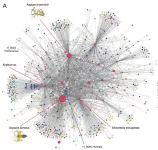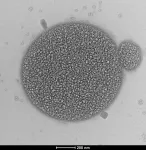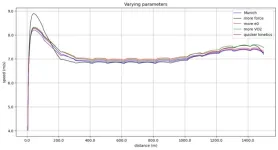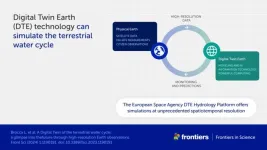Multinational collaborative research to improve climate-smart grain for Ethiopian farmers receives $4.9 million grant
Funding from The Bill & Melinda Gates Foundation will support improving the productivity of tef, a promising climate-resilient crop
2024-03-05
(Press-News.org) ST. LOUIS, MO, March 5, 2024 – The Donald Danforth Plant Science Center and the Ethiopian Institute of Agricultural Research (EIAR) have received a $4.9 million grant from The Bill & Melinda Gates Foundation to build on previous advances in gene editing of tef for reduced height and lodging resistance in advanced, farmer preferred tef lines.
The grant will support research to validate the improved semi dwarf tef in Ethiopia under greenhouse and multi location field conditions and generate lodging resistance traits in already improved breeding lines. In addition, new edits will be created in farmer-preferred varieties at EIAR where Ethiopian scientists will be trained on the development of cultivar-independent transformation and editing methodologies.
“By harnessing the genome editing technology, it was possible to achieve semidwarf lodging resistant lines that breeders have been looking for decades,” said Getu Duguma, PhD, senior research scientist and principal investigator at the Danforth Center. “The funding from the Gates Foundation will support bringing this technology closer to where farmers need it the most.”
Tef (Eragrostis tef) is the largest cereal cultivated by area in Ethiopia. More than 80 million people rely on the crop. It is central to food and economic security, providing up to two-thirds of the country's protein and dietary fiber. The ancient grain is gluten-free and rich in essential minerals such as iron, calcium, and magnesium. Tef is renowned for its adaptability to diverse growing conditions and drought tolerance, making it a promising candidate for a climate-resilient crop. While tef is grown mostly by smallholder farmers, it has growing importance for sustaining the rapidly growing urban population.
However, tef yields remain low and it is perhaps the only cereal crop whose cultivation has yet to be mechanized. Tef requires high labor input; seeding, weeding, harvest, and post-harvest which is typically carried out by women and family members. The challenge lies in the tall and weak stem causing the plants to fall over, a phenomenon known as "lodging" that is often affected by rain, wind, soil type, topography and the addition of nitrogen fertilizer. Lodging is a major impediment to modernizing tef production and inhibiting mechanized harvesting. The estimated annual production loss due to lodging amounts to 23-30%.
To address the issue of tef lodging, Duguma and his collaborators deployed gene editing to generate semi dwarf tef lines that are 10-50% shorter than the original. These improved lines have demonstrated lodging resistance in the Danforth Center’s greenhouse and Field Research Site.
“I believe that the outputs of this project will change the ‘ancient’ nature tef husbandry,” said Dejene Girma, PhD, the principal investigator of the project and director of Ag-Biotech Research at EIAR. “In addition, the generous grant from the foundation will provide EIAR the opportunity to train its researchers and develop gene editing capacity for this key food security crop and ultimately deliver lodging resistant tef lines to smallholder farmers.”
Learn more about Getu’s work with tef here.
About the Donald Danforth Plant Science Center
Founded in 1998, the Donald Danforth Plant Science Center is a not-for-profit research institute with a mission to improve the human condition through plant science. Research, education, and outreach aim to have an impact at the nexus of food security and the environment and position the St. Louis region as a world center for plant science. The Center’s work is funded through competitive grants from many sources, including the National Science Foundation, National Institutes of Health, U.S. Department of Energy, U.S. Agency for International Development, and The Bill & Melinda Gates Foundation, and through the generosity of individual, corporate, and foundation donors. Follow us on Twitter at @DanforthCenter.
About the Ethiopian Institute of Agricultural Research (EIAR)
The Ethiopian Institute of Agricultural Research is one of the oldest and largest agricultural public research institution in Africa. The Institute has evolved through several stages since its first initiation during the late 1940s. EIAR’s mission is to conduct research that will provide market competitive agricultural technologies that will contribute to increased agricultural productivity and nutrition quality, sustainable food security, economic development, and conservation of the integrity of natural resources and the environment. There are 22 fully fledged agricultural research centers administered by EIAR. These centers are strategically spread across the country to address agricultural problems in different agroecologies. EIAR works with national, regional, and international partners and collaborators based on mutually agreed frameworks in research, capacity building, and promoting scaling up of agricultural technologies. EIAR is mainly funded by the government of Ethiopia and supported by funding in the form of project grants from external sources.
###
Donald Danforth Plant Science Center contact: Karla Roeber, kroeber@danforthcenter.org
END
ELSE PRESS RELEASES FROM THIS DATE:
2024-03-05
In a series of studies, a team of astronomers has shed new light on the fascinating and complex process of planet formation. The stunning images, captured using the European Southern Observatory's Very Large Telescope (ESO’s VLT) in Chile, represent one of the largest ever surveys of planet-forming discs. The research brings together observations of more than 80 young stars that might have planets forming around them, providing astronomers with a wealth of data and unique insights into how planets arise in different regions of our galaxy.
“This is really a shift in our field of study,” says Christian Ginski, a lecturer at the University of Galway, Ireland, ...
2024-03-05
A theoretical experiment characterized the network architecture of a species-rich ecosystem over 8 months. Predator–prey interaction networks play a key role in structuring ecosystems, but ecological research has often treated such networks as static, despite the broadly accepted understanding of ecosystems as dynamic. Hirokazu Toju and colleagues followed the complex food webs between 50 predatory spider species and 974 prey species, including midges, springtails, mosquitoes, and aphids, for eight months. The studied ecosystem is a warm-temperate grassland ...
2024-03-05
In the Japanese art of Kintsugi, an artist takes the broken shards of a bowl and fuses them back together with gold to make a final product more beautiful than the original.
That idea is inspiring a new approach to managing plasma, the super-hot state of matter, for use as a power source. Scientists are using the imperfections in magnetic fields that confine a reaction to improve and enhance the plasma in an approach outlined in a new paper in the journal Nature Communications.
“This approach allows you to maintain ...
2024-03-05
Researchers built a model that can predict with 73.5% accuracy when a person will experience aesthetic chills: shivers, goosebumps, or a feeling of cold down the neck or spine elicited by aesthetic stimuli, such as beautiful music or an inspirational speech. Felix Schoeller and colleagues surveyed 2,937 people from Southern California, through an online platform, gathering data on their personalities, demographic backgrounds, and emotional state. The authors then exposed survey respondents to 40 emotion-evoking audiovisual clips sourced from social media, selected because commenters had reported experiencing aesthetic chills while watching and listening. ...
2024-03-05
PULLMAN, Wash. – Bacteria can be tricked into sending death signals to stop the growth of their slimy, protective homes that lead to deadly infections, a new study demonstrates.
The discovery by Washington State University researchers could someday be harnessed as an alternative to antibiotics for treating difficult infections. Reporting in the journal, Biofilm, the researchers used the messengers, which they named death extracellular vesicles (D-EVs), to reduce growth of the bacterial communities by up to 99.99% in laboratory experiments.
“Adding the death extracellular vesicles to ...
2024-03-05
Text-to-image generative AI systems like Midjourney, Stable Diffusion, and DALL-E can produce images based on text prompts that, had they been produced by humans, would plausibly be judged as “creative.” Some artists have argued that these programs are a threat to human creativity. If AI comes to be relied on to produce most new visual works, drawing on what has been done before, creative progress could stagnate. Eric Zhou and Dokyun “DK” Lee investigated the impact of text-to-image AI tools on human creativity, seeking to understand ...
2024-03-05
Since its introduction, cryptocurrency governance has been one of the most controversial global financial topics. While some countries have established elaborate regulations for cryptocurrencies, many countries are still reluctant to oversee the markets, and some have outright banned them. Most studies suggest that public agencies naturally want to regulate markets and bring them into their purview. However, the significant differences in cryptocurrency regulation over the world call this view into question. Moreover, these differences cannot be explained by the development ...
2024-03-05
While the transportation sector has witnessed a dramatic shift toward electric vehicles (EVs), the idea of using hydrogen as a clean and efficient fuel for transportation has been explored for many decades. These vehicles emit water on combustion, and since they are based on the production of existing engine vehicles, they are expected to have a lower manufacturing carbon footprint than EVs. However, storing and transporting hydrogen requires high pressures and low temperatures, which are energy-intensive processes. To address this, ammonia has ...
2024-03-05
How to optimise running? A new mathematical model1 has shown, with great precision, the impact that physiological and psychological parameters have on running performance and provides tips for optimised training. The model grew out of research conducted by a French-British team including two CNRS researchers2, the results of which will appear on March 5th 2024 in the journal Frontiers in Sports and Active Living.
This innovative model was developed thanks to extremely precise data3 from the performances of Matthew Hudson-Smith (400m), Femke Bol (400m), and ...
2024-03-05
The water cycle looks simple in theory — but human impacts, climate change, and complicated geography mean that in practice, floods and droughts remain hard to predict. To model water on Earth, you need incredibly high-resolution data across an immense expanse, and you need modeling sophisticated enough to account for everything from snowcaps on mountains to soil moisture in valleys. Now, scientists funded by the European Space Agency have made a tremendous step forward by building the most detailed models created to date.
“Simulating ...
LAST 30 PRESS RELEASES:
[Press-News.org] Multinational collaborative research to improve climate-smart grain for Ethiopian farmers receives $4.9 million grant
Funding from The Bill & Melinda Gates Foundation will support improving the productivity of tef, a promising climate-resilient crop






